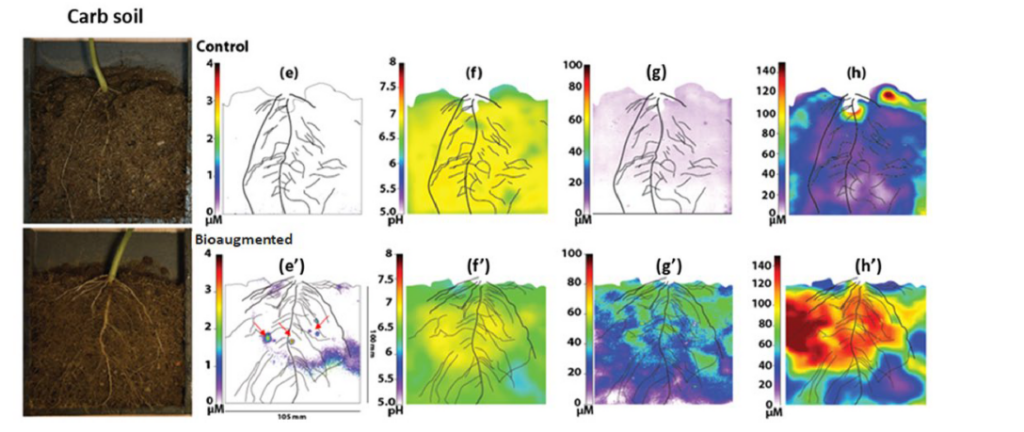Bacterial siderophores: deciphering their role in the mobilization and phyto-availability of copper in soils
In excessively high doses in soils, as is the case in some vineyards treated with Bordeaux mixture for more than a century to control mildew, copper (Cu) can be toxic for certain organisms that inhabit them. This is why, in addition to better understanding the biogeochemical functioning of these soils, the question of their depollution arises.
The work carried out within the framework of the POLLUSOLS and VITALICUIVRE projects has focused on certain soil bacteria known to produce siderophores. These metal complexing agents released into the soil are used by bacteria to mobilize the iron they need (which is then made bioavailable). However, these bacteria could also increase the bioavailability of other metals in the soil, including copper, and thus promote its uptake by plants.
Based on the detailed understanding of Cu-soil-bacteria-plant interactions, an innovative process of copper extraction by sunflower associated with a bacterium of the genus Pseudomonas has been successfully tested in order to reduce the copper load of vineyard soils.
This work, which involved the Nantes and Angers sites of the LPG as well as BRGM and INRAE Bordeaux, is part of the POLLUSOLS and VITALICUIVRE projects coordinated by Thierry Lebeau and supported by OSUNA.
Copper-contaminated vineyard soils were cultivated with sunflower (accumulator plant) under controlled laboratory conditions. One of the conditions consisted in “bioaugmenting” these soils, i.e. inoculating them with bacteria of the genus Pseudomonas selected for their proven potential to produce complexing agents (siderophores such as pyoverdine) and to increase both plant growth and tolerance to metal toxicity.
Non-invasive imaging techniques – 2D-DET (Diffusive Equilibrium in Thin film) and 2D-DGT (Diffusive Gradient in Thin film) – allowed to simultaneously visualize the root system and the dynamics of elements in the soil to better understand the physico-chemical and biological mechanisms that control the mobility and the phyto-availability of elements in the soil.

Rhizosphere mapping (DET) (Fig. 1) revealed the presence of siderophores (pyoverdine) closest to the roots of a Pseudomonas-inoculated carbonated vineyard soil and, concomitantly, a significant increase in dissolved iron and phosphate concentrations. In the soil solution, the increase in iron and phosphate concentrations was confirmed as well as those of Cu, Al, Mn, Zn, NO3-, NH4+.
However, the increase in the mobility of the monitored elements (2D-DET) did not always lead to an increase in bioavailability (2D-DGT, data not shown), especially that of copper. Indeed, the production of pyoverdine resulted in an increase in the total amount of Cu in solution (Fig. 2a) but simultaneously in a decrease in the amount of Cu2+ known as “free copper” (Fig. 2b), the form preferentially assimilated by plants. One might therefore have expected a decrease in phytoextraction performance. However, these performances doubled (Fig. 2c), which suggests that the pyoverdine-Cu complex dissociated in the rhizosphere before Cu2+ was taken up by the plant.

Finally, it should be noted that the performance of Cu phytoextraction associated with bioaugmentation was higher in carbonate soils, due to the lower bioavailability of iron in these alkaline soils, which leads to an increased production of pyoverdine involved in Cu mobilization.
Phyto-availability and consequently phytoextraction performance could be further increased by promoting the decomplexation near the roots of the pyoverdine-Cu complex but also that of many dissolved organic materials that also complex copper.
References :
D’Incau E., Lépinay A., Capiaux H., Gaudin P., Cornu J.Y., Lebeau T. (2022) Effect of Pseudomonas putida-producing pyoverdine on copper uptake by Helianthus annuus cultivated on vineyard soils. Science of the Total Environment, 802, https://doi.org/10.1016/j.scitotenv.2021.152113
Randriamamonjy S., Mouret A., Metzger E., Gaudin P., La C., Capiaux H., Launeau P., Giraud M., Cornu J-Y., Lebeau T. (2021). 2D distribution of Pseudomonas fluorescens activities at the soil-root interface of sunflower grown on vineyard soils: effects on copper uptake. Soil Biology and Biochemistry, 163, (DOI: 10.1016/j.soilbio.2021.108462).
Contact : Thierry Lebeau
Published on December 21st, 2022

